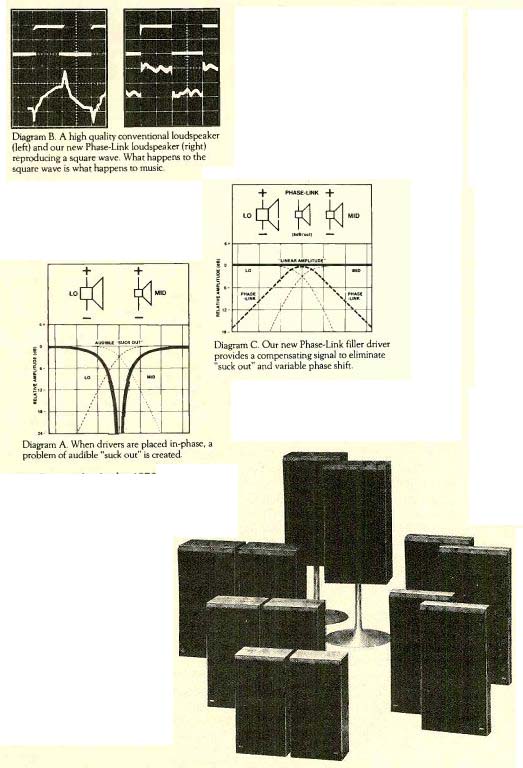
One reason you may be looking for new speakers could be the phase distortion present in those you listen to now.
Phase Distortion Explained. Phase distortion is heard as a blurred sound picture and prevents accurate localization of instruments. It is most noticeable in the lower mid-frequency range at higher volumes. It occurs in most conventional, multi-way loudspeakers at the crossover point, when the same note is being reproduced by two drivers. Be cause today's high quality loudspeakers have virtually solved the problems of frequency response as well as harmonic and intermodulation distortion, the study and correction of phase distortion is all the more important if you are to literally recreate the original performance.
--- Diagram A. When drivers are placed in-phase, a problem of audible "suck out' is created.
Our Research. At the 1973 AES convention in Rotterdam, two Bang & Olufsen engineers, Madsen and Hansen, presented a paper on audible phase distortion. This paper represented three years of concentrated research within which they developed an electronic crossover, tri amplified loudspeaker that allowed them to demonstrate three important facts: 1. Phase distortion did indeed exist in loudspeakers. 2. That it was audible. (Hundreds of hours of critical listening tests confirmed this.) 3. That it could be effectively eliminated through sophisticated technology.
--- Diagram B. A high quality conventional loudspeaker (left) and our new Phase-Link loudspeaker (right) reproducing a square wave. What happens to the square wave is what happens to music.
Our Product. The experimental speaker developed by Madsen and Hansen was far too expensive to consider for distribution to the audio consumer.
A practical solution had to be found.
At this point, Bang & Olufsen engineer E. Baekgaard began his work with mathematical computer simulation. He discovered that the fixed phase shift, present in most conventional speakers (drivers alternated 180° out-of-phase) could be "cured" by placing all drivers in-phase. However, when this was done, an audible amplitude "suck out" was created (See diagram A.). It was to solve this problem that an additional narrow band filler driver--the Phase-Link Driver--was developed. Its compensating signal cured the amplitude "suck out" and the variable phase shift. It made the audible output of the loud speaker virtually identical to the input-the square wave, for example.
Another Refinement. Phase-Link (tm) loudspeakers have their drivers mounted on a common acoustic axis so that the sound from each driver will reach your ears simultaneously. That is the reason for our slightly canted grill.
--- Diagram C. Our new Phase-Link filler driver provides a compensating signal to eliminate “suck out" and variable phase shift.
Your Listening Experience. The importance of our new Phase-Links technology and square wave tests is of course determined by the fidelity of the music recreated by our speakers. It is your sensitivity to the accurate reproduction of music that will give them their severest test. It is our technology which will insure they pass, for rarely has technology served music so well.
Because the ear is sensitive to phase distortion mainly in the lower mid-frequencies, Phase-Link is used between the low-frequency driver and the mid range unit in the high power, 3-way systems (M-70, S-60) but not between the mid-range and tweeter. In medium-power, 2-way systems, one Phase-Link driver is used in 12dB/oct. filter combinations (S-45, P-45). Low-power, 2-way systems (S-30, P-30) do not utilize a Phase-Link driver but instead eliminate phase distortion through a sophisticated 6dB/oct. filter technique.
Bang & Olufsen speakers include the M-70, shown on trumpet stand (supplied), three bookshelf models, the S-60, S-45, and S-30, and two wall panel speakers, the P-45 and P-30.
Bang & Olufsen Bang & Olufsen of America, Inc., 515 Busse Road, Elk Grove Village, Illinois 60007, USA.
Also see: